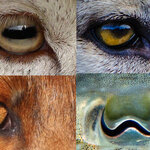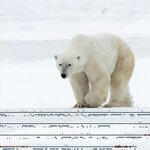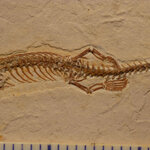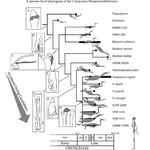Evolution

New species evolve whenever a lineage splits off into several branches and so a common metaphor for evolution has been to describe evolution as a 'tree of life', where every branch constitutes a species.
But since about 99.999% of all species that have ever existed are already extinct, and we have never even known about them, the tree is more like a bush with things constantly growing and falling off. Last year, a consortium of some hundred researchers reported that the relationship between all major bird clades had been mapped out by analyzing the complete genome of around 50 bird species.…

Wolves and foxes are closely related and share many of the same characteristics.
But look at their eyes – where wolves have rounded pupils like humans, foxes instead have a thin vertical line.
But it isn’t just canines –across the animal kingdom, pupils come in all shapes and sizes. So why the differences?
It’s a question that has long interested scientists working on vision and optics. In a new study published in the journal Science Advances, colleagues from Durham, Berkeley and I explain why these pupil shapes have developed.
Goats, sheep, horses, domestic cats, and numerous other animals…

Scientists have reconstructed part of the male chromosome in polar bears. They were able to assign 1.9 million base pairs specifically to the polar bear Y chromosome and show that more than 100,000 years ago, the male polar bear lineages split and developed in two separate genetic groups.
The polar bear is the world’s largest land-dwelling predator and is hard to miss. Nevertheless, it is difficult to study the evolution this arctic resident: Polar bears live and die on the frozen sea, and their remains are seldom found.
“In order to gain insights into the evolutionary development of Ursus…

How did the snake get its slither? Ever since the crafty serpent in Genesis tempted Eve into eating the forbidden fruit, we’ve been fascinated by snakes. And, despite our interest in this animal, we have a poor understanding of how it actually evolved.
But scientists have now released a new study on the fossil of a snake that appears to have lived between 100m and 146m years ago. And what’s more it had legs.
The reasons we know so little about snake evolution is because there are so few fossils. Molecular data suggests that snakes appeared within the squamate family tree – including lizards…

By Michael Greshko, Inside Science -- On Thursday, scientists announced a new, comprehensive re-analysis of the "Kennewick Man," an 8,500-year-old North American skeleton. Since it was discovered in 1996 in Kennewick, Washington, the nearly complete human skeleton has been at the center of a long-churning debate about how science and culture should be considered when determining the fate of human artifacts and remains.
The new findings, published online in the journal Nature, include the first successful DNA analysis of the remains and a thorough deconstruction of previous studies' underlying…

Neanderhals became extinct about 40,000 years ago but contributed on average one to three percent to the genomes of present-day Eurasians. Researchers have now analyzed DNA from a 37,000 to 42,000-year-old human mandible from Oase Cave in Romania and have found that six to nine percent of this person's genome came from Neanderthals, more than any other human sequenced to date.
Because large segments of this individual's chromosomes are of Neanderthal origin, a Neanderthal was among his ancestors as recently as four to six generations back in his family tree. This shows that some of the…

Several genes have been lost from the Y chromosome in humans and other mammals but essential Y genes are rescued by relocating to other chromosomes, according to a new study.
The Y chromosome is dramatically smaller than the X chromosome and has already lost nearly all of the 640 genes it once shared with the X chromosome.
An extreme example of genes disappearing from the Y chromosome can be found in the Ryukyu spiny rat, which is indigenous to a single island in Japan. In this species, the Y chromosome has disappeared completely, with many Y-linked genes moving to either the X chromosome or…

A unique adaptation in the foot of birds is the presence of a thumb-like opposable toe, which allows them to grasp and perch.
In their dinosaur ancestors, this toe was small and non- opposable, and did not even touch the ground, resembling the dewclaws of dogs and cats.
The embryonic development of birds provides a parallel of this evolutionary history: The toe starts out like their dinosaur ancestors, but then its base (the metatarsal) becomes twisted, making it opposable. Brazilian researcher Joâo Botelho, working at the lab of Alexander Vargas at the University of Chile, decided to study…

A new study of some Hesperornithiform bird fossils from the Cretaceous shows how several separate lineages evolved adaptations for diving. They began to go fishing.
Living at the same time as the dinosaurs, Hesperornithiform
has been found in North America, Europe and Asia in 65–95 million years old rocks. Dr. Alyssa Bell and Professor Luis Chiappe of the Dinosaur Institute, Natural History Museum of Los Angeles County, undertook a detailed analysis of their evolution, showing that separate lineages became progressively more adept at diving into water to catch fishes, like modern day…

Does the world really need men?
It has been suggested that, in the age of cloning – and with enough sperm banks around to populate several future generations – the question is legitimate.
However, new research suggests that the reason that we need two sexes is because it improves the overall genetic quality of a species and reduces the risk of population extinction.
The question of why sex is so widespread across nature has intrigued and puzzled scientists for a very long time. From a biological perspective, the purpose of life is to pass on your genes to the next generation. Asexual…